Polish–Lithuanian Commonwealth
Kingdom of Poland and the Grand Duchy of Lithuania Królestwo Polskie i Wielkie Księstwo Litewskie ( Latin) | |||||||||||||||
|---|---|---|---|---|---|---|---|---|---|---|---|---|---|---|---|
| 1569–1795[1] | |||||||||||||||
Motto:
| |||||||||||||||
| Anthem: vassal states (light green) at its peak in 1619 | |||||||||||||||
| Capital | Kraków[2] (1569–1793) (de facto 1569–1596) Warsaw[2] (1793–1795) (de facto 1596–1795) | ||||||||||||||
| Common languages | Official: Polish and Latin Regional:
| ||||||||||||||
| Religion | Official: Catholicism[3] Minority:
| ||||||||||||||
Sigismund II | |||||||||||||||
• 1764–1795 (last) | Stanisław II | ||||||||||||||
Chancellor of Poland | |||||||||||||||
• 1569–1576 (first) | Walenty Dembiński | ||||||||||||||
• 1793–1795 (last) | Antoni Sułkowski | ||||||||||||||
| Grand Chancellor of Lithuania | |||||||||||||||
• 1569–1584 (first) | Mikołaj Radziwiłł | ||||||||||||||
• 1764–1795 (last) | Joachim Chreptowicz | ||||||||||||||
| Legislature | General sejm | ||||||||||||||
| Senate | |||||||||||||||
| Chamber of Deputies | |||||||||||||||
| Historical era | Early modern period | ||||||||||||||
| 1 July 1569 | |||||||||||||||
| 5 August 1772 | |||||||||||||||
| 3 May 1791 | |||||||||||||||
| 23 January 1793[1] | |||||||||||||||
| 24 October 1795[1] | |||||||||||||||
| Area | |||||||||||||||
| 1582[8] | 815,000 km2 (315,000 sq mi) | ||||||||||||||
| 1618[9][10] | 1,000,000 km2 (390,000 sq mi) | ||||||||||||||
| Population | |||||||||||||||
• 1582[8] | 8,000,000 | ||||||||||||||
| |||||||||||||||
The Polish–Lithuanian Commonwealth,
The Commonwealth was established as a single entity by the
The state possessed an idiosyncratic system of governance and its Golden Liberty placed controls upon monarchical authority, a precursor to modern concepts of democracy.[22] Legislation was enacted by the General Sejm, a bicameral legislature (parliament) administered by the szlachta nobility, and the king was bound to comply with the constitutional principles dictated by the Henrician Articles. The country also maintained unprecedented levels of ethnic diversity and relative religious tolerance, guaranteed by the Warsaw Confederation Act of 1573,[23][24][d] though the degree of religious freedom was not always uniform and varied over time.[25] Poland acted as the dominant partner in the union.[26] Polonization of nobles was generally voluntary,[27][26] but Catholicism imposed across the large realm was met with resistance from some minorities.[28]
After several decades of prosperity,
Name
The official name of the state was the Kingdom of Poland and the Grand Duchy of Lithuania (
In the 17th century and later it was also known as the 'Most Serene Commonwealth of Poland' (
Western Europeans often simplified the name to 'Poland' and in most past and modern sources it is referred to as the Kingdom of Poland, or just Poland.
Other informal names include the 'Republic of Nobles' (Polish: Rzeczpospolita szlachecka) and the 'First Commonwealth' (Polish: I Rzeczpospolita) or 'First Polish Republic' (Polish: Pierwsza Rzeczpospolita), the latter relatively common in historiography to distinguish it from the Second Polish Republic.
History
Prelude (1370–1569)

The
The Polish lords rejected Mary in favour of her younger sister Jadwiga, partly due to Mary's association with
Union of Lublin (1569)
Several minor agreements were struck before unification, notably the
A fierce proponent of a single unified Commonwealth was Sigismund II Augustus, who was childless and ailing. According to historians, it was his active involvement which hastened the process and made the union possible.[59] A parliament (sejm) convened on 10 January 1569 in the city of Lublin, attended by envoys from both nations. It was agreed that the merger will take place the same year and both parliaments will be fused into a joint assembly.[60] No independent parliamentary convocation or diet was henceforth permitted.[60] Subjects of the Polish Crown were no longer restricted in purchasing land on Lithuanian territory and a single currency was established.[61] Whilst the military remained separate, a unified foreign policy meant that Lithuanian troops were obliged to contribute during a conflict not to their advantage.[62] As a result, several Lithuanian magnates deplored the accords and left the assembly in protest.[63] Sigismund II used his authority as grand duke and enforced the Act of Union in contumaciam. In fear, the absent nobles promptly returned to the negotiations.[64] The Union of Lublin was passed by the gathered deputies and signed by attendees on 1 July, thus creating the Polish–Lithuanian Commonwealth.[63]
Sigismund's death in 1572 was followed by an interregnum during which adjustments were made to the constitutional system; these adjustments significantly increased the power of the Polish nobility and established a truly elective monarchy.[65]
Apex and the Golden Age (1573–1648)

On 11 May 1573,
The interregnum concluded on 12 December 1575 when primate

In 1587,
Sigismund III then initiated a policy of expansionism, and invaded Russia in 1609 when that country was plagued by a civil war known as the Time of Troubles. In July 1610, the outnumbered Polish force comprising winged hussars defeated the Russians at the Battle of Klushino, which enabled the Poles to take and occupy Moscow for the next two years.[82] The disgraced Vasili IV of Russia was transported in a cage to Warsaw where he paid a tribute to Sigismund; Vasili was later murdered in captivity.[83] The Commonwealth forces were eventually driven out on 4 November 1612 (celebrated as Unity Day in Russia). The war concluded with a truce that granted Poland–Lithuania extensive territories in the east and marked its largest territorial expansion.[84] At least five million Russians died between 1598 and 1613, the result of continuous conflict, famine and Sigismund's invasion.[85]
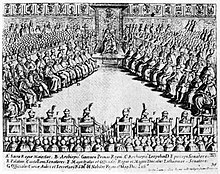
The
During this period, Poland was experiencing a cultural awakening and extensive developments in arts and architecture; the first Vasa king openly sponsored foreign painters, craftsmen, musicians and engineers, who settled in the Commonwealth at his request.[89]
Sigismund's eldest son,
Deluge, rebellions and Vienna (1648–1696)
The Commonwealth's power and stability began waning after a series of blows during the following decades. Władysław's brother,
A major rebellion of self-governed
The other blow to the Commonwealth was a Swedish invasion in 1655, known as the Deluge, which was supported by troops of Transylvanian Duke George II Rákóczi and Frederick William, Elector of Brandenburg. Under the Treaty of Bromberg in 1657, Catholic Poland was forced to renounce its suzerainty over Protestant Prussia; in 1701 the once-insignificant duchy was transformed into the Kingdom of Prussia, which became a major European power in the 18th century and proved to be Poland's most enduring foe.[citation needed]
In the late 17th century, the king of the weakened Commonwealth,
Political turmoil and the enlightenment (1697–1771)

John Sobieski's death in 1696 arguably ended the period of national sovereignty, and Poland's relative authority over the region dwindled swiftly. By the 18th century, destabilization of its political system brought the Commonwealth to the brink of
The House of Wettin ruled Poland–Lithuania and Saxony simultaneously, dividing power between the two states. In spite of his controversial means of attaining power, Augustus II lavishly spent on the arts and left an extensive cultural and architectural (Baroque) legacy in both countries. In Poland, he expanded Wilanów and facilitated the refurbishment of the Warsaw Royal Castle into a modern palatial residence.[104] Countless landmarks and monuments in the city bear a name referencing the Saxon kings, notably Saxon Garden, Saxon Axis and the former Saxon Palace.[105] The period saw the development of urban planning, street allocation, hospitals, schools (Collegium Nobilium), public parks and libraries (Załuski Library). First manufactories producing on a mass scale were opened to satisfy the demands of the nobility as consumers.[106]
At the height of the Great Northern War a coalition (Warsaw Confederation) against Augustus II was formed by Stanisław Leszczyński and other magnates sponsored by Sweden. The Polish–Lithuanian Commonwealth was formally neutral at this point, as Augustus entered the war as Elector of Saxony. Disregarding Polish negotiation proposals supported by the Swedish parliament, Charles crossed into the Commonwealth and vanquished the Saxe-Polish forces at the Battle of Kliszów in 1702 and at the Battle of Pułtusk in 1703.[107] Charles then succeeded in dethroning Augustus and coercing the Sejm (parliament) to replace him with Stanisław in 1704.[108] Augustus regained the throne in 1709,[109] but his own death in 1733 sparked the War of the Polish Succession in which Stanisław once more attempted to seize the crown, this time with the support of France.[110] The Pacification Sejm culminated in Augustus III succeeding his father.[111]
The relative peace and inactivity that followed only weakened Poland's reputation on the world stage.[112] Aleksander Brückner noted that Polish customs and traditions were abandoned in favour of everything foreign, and neighbouring states continued to exploit Poland to their advantage.[112] Moreover, Western Europe's increasing exploitation of resources in the Americas rendered the Commonwealth's supplies less crucial which resulted in financial losses.[113] Augustus III spent little time in the Commonwealth, instead preferring the Saxon city of Dresden. He appointed Heinrich von Brühl as viceroy and minister of Polish affairs who in turn left the politics to Polish magnate families, such as the Czartoryskis and the Radziwiłłs.[114] It was also during this period that the Polish Enlightenment began to sprout.
Partitions (1772–1795)

In 1764, aristocrat Stanisław August Poniatowski was elected monarch with the connivance and support of his former lover Catherine the Great, a German noblewoman who became Empress of Russia.[115]
Poniatowski's attempts at reform were met with staunch resistance both internally and externally. Any goal of stabilizing the Commonwealth was dangerous for its ambitious and aggressive neighbours. Like his predecessors, he sponsored artists and architects. In 1765 he founded the Warsaw Corps of Cadets, the first state school in Poland for all classes of society.[116] In 1773 the king and parliament formed the Commission of National Education, the first Ministry of Education in European history.[117][118] In 1792, the king ordered the creation of Virtuti Militari, the oldest military decoration still in use.[119] Stanisław August also admired the culture of Ancient kingdoms, particularly Rome and Greece; Neoclassicism became the dominant form of architectural and cultural expression.
Politically, however, the vast Commonwealth was in steady decline and by 1768, it started to be considered by Russians as a
State organization and politics
Golden Liberty

The political doctrine of the Commonwealth was our state is a republic under the presidency of the King.
The monarch's power was limited in favour of a sizable noble class. Each new king had to pledge to uphold the Henrician Articles, which were the basis of Poland's political system (and included near-unprecedented guarantees of
The foundation of the Commonwealth's political system, the "
- election of the king by all nobles wishing to participate, known as wolna elekcja (free election);
- Sejm, the Commonwealth parliament which the king was required to hold every two years;
- pacta conventa (Latin), "agreed-to agreements" negotiated with the king-elect, including a bill of rights, binding on the king, derived from the earlier Henrician Articles.
- ]
- insurrection), the right of szlachtato form a legal rebellion against a king who violated their guaranteed freedoms;
- liberum veto (Latin), the right of an individual Sejm deputy to oppose a decision by the majority in a Sejm session; the voicing of such a "free veto" nullified all the legislation that had been passed at that session; during the crisis of the second half of the 17th century, Polish nobles could also use the liberum veto in provincial sejmiks;
- confederatio), the right to form an organization to force through a common political aim.
The three regions (see below) of the Commonwealth enjoyed a degree of
Golden Liberty created a state that was unusual for its time, although somewhat similar
This political system unusual for its time stemmed from the ascendance of the szlachta noble class over other social classes and over the political system of monarchy. In time, the szlachta accumulated enough privileges (such as those established by the Nihil novi Act of 1505) that no monarch could hope to break the szlachta's grip on power. The Commonwealth's political system is difficult to fit into a simple category, but it can be tentatively described as a mixture of:
- confederation and federation, with regard to the broad autonomy of its regions. It is, however, difficult to decisively call the Commonwealth either confederation or federation, as it had some qualities of both;
- oligarchy, as only the szlachta (nobility) – around 15% of the population – had political rights;[94]
- democracy, since all the szlachta were equal in rights and privileges, and the Sejm could veto the king on important matters, including legislation (the adoption of new laws), foreign affairs, declaration of war, and taxation (changes of existing taxes or the levying of new ones). Also, the 15% of Commonwealth population who enjoyed those political rights (the szlachta)[131] was a substantially larger percentage than in majority European countries even in the nineteenth century;[132] note that in 1820 in France only about 1.5% of the male adult population had the right to vote, and in 1840 in Belgium, only about 5%.[131][132]
- elective monarchy, since the monarch, elected by the szlachta, was Head of State;
- constitutional monarchy, since the monarch was bound by pacta conventa and other laws, and the szlachta could disobey any king's decrees they deemed illegal.
Magnate oligarchy
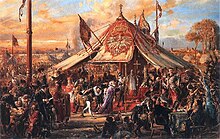
The end of the Jagiellonian dynasty in 1572 – after nearly two centuries – disrupted the fragile equilibrium of the Commonwealth's government. Power increasingly slipped away from the central government to the nobility.[67]
When presented with periodic opportunities to fill the throne, the szlachta exhibited a preference for foreign candidates who would not establish a strong and long-lasting
The
Late reforms

The Commonwealth did eventually make a serious effort to reform its political system, adopting in 1791 the Constitution of 3 May 1791, which historian Norman Davies calls the first of its kind in Europe.[37] The revolutionary Constitution recast the erstwhile Polish–Lithuanian Commonwealth as a Polish–Lithuanian federal state with a hereditary monarchy and abolished many of the deleterious features of the old system.
The new constitution:
- abolished the liberum veto and banned the szlachta's confederations;
- provided for a judicialbranches of government;
- established "popular sovereignty" and extended political rights to include not only the nobility but the bourgeoisie;
- increased the rights of the peasantry;
- preserved religious tolerance (but with a condemnation of apostasyfrom the Catholic faith).
These reforms came too late, however, as the Commonwealth was immediately invaded from all sides by its neighbors, which had been content to leave the Commonwealth alone as a weak buffer state, but reacted strongly to attempts by king
Economy
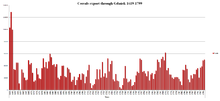
The economy of the Commonwealth was predominantly based on agricultural output and trade, though there was an abundance of
The country played a significant role in the supply of
The agricultural sector was dominated by
The owner of a folwark usually signed a contract with merchants of Gdańsk, who controlled 80% of this inland trade, to ship the grain north to that seaport on the Baltic Sea.[160] Countless rivers and waterways in the Commonwealth were used for shipping purposes, including the Vistula, Pilica, Bug, San, Nida, Wieprz, and Neman. The rivers had relatively developed infrastructure, with river ports and granaries. Most of the river shipping moved north, southward transport being less profitable, and barges and rafts were often sold off in Gdańsk for lumber. Grodno become an important site after formation of a customs post at Augustów in 1569, which became a checkpoint for merchants travelling to the Crown lands from the Grand Duchy.[161]
Urban population of the Commonwealth was low compared to Western Europe. Exact numbers depend on calculation methods. According to one source, the urban population of the Commonwealth was about 20% of the total in the 17th century, compared to approximately 50% in the Netherlands and Italy (
Several ancient
Military
The military in the Polish–Lithuanian Commonwealth evolved from the merger of the armies from the Polish Kingdom and from the Grand Lithuanian Duchy, though each state maintained its own division.
The most prestigious formation of the two respective armes were their 16th- and 17th-century
The armies of those states differed from the organization common in other parts of Europe; according to Bardach, the
Several years before the Union of Lublin, the Polish obrona potoczna was reformed, as the
Following the end of the Commonwealth, the Polish-Lithuanian military tradition would be continued by the Napoleonic Polish Legions and the Army of the Duchy of Warsaw.[179]
Culture
Science and literature

The Commonwealth was an important European center for the development of modern social and political ideas. It was famous for its rare quasi-democratic political system, praised by
With its political system, the Commonwealth gave birth to
The works of many Commonwealth authors are considered classics, including those of Jan Kochanowski (Pic. 10), Wacław Potocki, Ignacy Krasicki, and Julian Ursyn Niemcewicz. Many szlachta members wrote memoirs and diaries. Perhaps the most famous are the Memoirs of Polish History by Albrycht Stanisław Radziwiłł (1595–1656) and the Memoirs of Jan Chryzostom Pasek (ca. 1636–ca. 1701). Jakub Sobieski (1590–1646) (father of John III Sobieski) wrote notable diaries. During the Khotyn expedition in 1621 he wrote a diary called Commentariorum chotinensis belli libri tres (Diary of the Chocim War), which was published in 1646 in Gdańsk. It was used by Wacław Potocki as a basis for his epic poem, Transakcja wojny chocimskiej (The Progress of the War of Chocim). He also authored instructions for the journey of his sons to Kraków (1640) and France (1645), a good example of liberal education of the era.[185]
Art and music
The art and music of the Commonwealth was largely shaped by prevailing European trends, though the country's minorities, foreigners as well as native folk cultures also contributed to its versatile nature. A common art form of the
The economic, cultural and political ties between
The religious cultures of Poland–Lithuania coexisted and penetrated each other for the entirety of the Commonwealth's history – the
Music was a common feature of religious and secular events. To that end many noblemen founded church and school choirs, and employed their own ensembles of musicians. Some, like
Architecture

The architecture of the cities in the Polish–Lithuanian Commonwealth reflected a combination of Polish, German and Italian trends.

The introduction of
Magnates often undertook construction projects as monuments to themselves: churches, cathedrals, monasteries (Pic. 14), and palaces like the present-day Presidential Palace in Warsaw and Pidhirtsi Castle built by Grand Hetman Stanisław Koniecpolski. The largest projects involved entire towns, although in time many of them would lapse into obscurity or were abandoned. These towns were generally named after the sponsoring magnate. Among the most prominent is Zamość, founded by Jan Zamoyski and designed by the Italian architect Bernardo Morando as an ideal city. The magnates throughout Poland competed with the kings. The monumental castle Krzyżtopór, built in the style palazzo in fortezza between 1627 and 1644, had several courtyards surrounded by fortifications. Similar fortified complexes include castles in Łańcut and Krasiczyn.[citation needed]
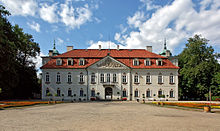
The fascination with the culture and art of the
Szlachta and Sarmatism
The prevalent ideology of the szlachta became "Sarmatism", named after the Sarmatians, alleged ancestors of the Poles.[140] This belief system was an important part of szlachta culture, penetrating all aspects of its life. Sarmatism enshrined equality among szlachta, horseback riding, tradition, provincial quaint life in manor houses, peace and pacifism; championed oriental-inspired souvenirs or attire for men (żupan, kontusz, sukmana, pas kontuszowy, delia, szabla); favoured European Baroque architecture; endorsed Latin as a language of thought or expression; and served to integrate the multi-ethnic nobility by creating an almost nationalistic sense of unity and of pride in Golden Liberty.[140]
In its early, idealistic form, Sarmatism represented a positive cultural movement: it supported religious belief, honesty, national pride, courage, equality and freedom. In time, however, it became distorted. Late extreme Sarmatism turned belief into bigotry, honesty into political naïveté, pride into arrogance, courage into stubbornness and freedom into anarchy.[209] The faults of Sarmatism were blamed for the demise of the country from the late 18th century onwards. Criticism, often one-sided and exaggerated, was used by the Polish reformists to push for radical changes. This self-deprecation was accompanied by works of German, Russian and Austrian historians, who tried to prove that it was Poland itself that was to blame for its fall.[210]
Demographics

The Polish–Lithuanian Commonwealth was immensely
Prior to the union with Lithuania, the Kingdom of Poland was much more homogenous; approximately 70% of the population was Polish and Roman Catholic.[214] With the creation of the Commonwealth, the number of Poles in comparison to the total population decreased to 50%.[215] In 1569, the population stood at 7 million, with roughly 4.5 million Poles, 750,000 Lithuanians, 700,000 Jews and 2 million Ruthenians.[216] Historians Michał Kopczyński and Wojciech Tygielski suggest that with the territorial expansion after the Truce of Deulino in 1618, the Commonwealth's population reached 12 million people, of which Poles constituted only 40%.[215][17] At that time the nobility made up 10% of the entire population and the burghers around 15%.[17] The average population density per square kilometer was: 24 in Mazovia, 23 in Lesser Poland, 19 in Greater Poland, 12 in Lublin palatinate, 10 in the Lwów area, 7 in Podolia and Volhynia, and 3 in the Kiev Voivodeship. There was a tendency for the people from the more densely inhabited western territories to migrate eastwards.[217]

A sudden change in the country's demographics occurred in the mid-17th century.
The most multicultural and robust city in the country was
Despite guaranteed religious tolerance, gradual Polonization and Counter-Reformation sought to minimise the Commonwealth's diversity; the aim was to root out some minorities by imposing the Polish language, Latin, Polish culture and the Roman Catholic religion where possible.[222] By the late 18th century, the Lithuanian language, culture and identity became vulnerable;[222] the country's name was changed to "Commonwealth of Poland" in 1791.
Religion
The
Poland retained religious freedom laws during an era when religious persecution was an everyday occurrence in the rest of Europe.
"This country became a place of shelter for heretics" – Cardinal Stanislaus Hosius, papal legate to Poland.[228]
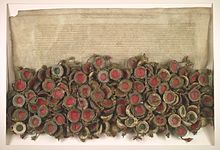
To be Polish, in remote and multi-ethnic parts of the Commonwealth, was then much less an index of
As a result, in the eastern territories a Polish (or Polonised) aristocracy dominated a peasantry whose great majority was neither Polish nor Catholic. Moreover, the decades of peace brought huge
Until the
The Crown had about double the population of Lithuania and five times the income of the latter's treasury. As with other countries, the borders, area and population of the Commonwealth varied over time. After the
Languages

- Polish – officially recognised;[239] dominant language, used by most of the Commonwealth's nobility[239][240][241][242] and by the peasantry in the Crown province;[243] official language in the Crown chancellery and since 1697 in the Grand Duchy chancellery.[244] Dominant language in the towns.[243]
- Latin – officially recognised;[239][245] commonly used in foreign relations[244] and popular as a second language among some of the nobility.[246]
- French – not officially recognised; replaced Latin at the royal court in Warsaw in the beginning of the 18th century as a language used in foreign relations and as genuine spoken language.[247][248] It was commonly used as a language of science and literature and as a second language among some of the nobility.[249]
- Ruthenian – also known as Chancellery Slavonic;[244] officially recognised;[239] official language in the Grand Duchy chancellery until 1697 (when replaced by Polish) and in Bratslav, Chernihiv, Kiev and Volhynian voivodeships until 1673;[250][251] used in some foreign relations[244][245][252] its dialects (modern Belarusian and Ukrainian) were widely used in the Grand Duchy and eastern parts of the Crown as spoken language.
- Ducal Prussia (Polish fief).
- German – officially recognised;[239] used in some foreign relations,[244] in Ducal Prussia and by German minorities especially in the Royal Prussia and Greater Poland.[243][258]
- Hebrew – officially recognised;[239] and Aramaic used by Jews for religious, scholarly, and legal matters.
- Yiddish – not officially recognised;[259][260] used by Jews in their daily life[243]
- Italian – not officially recognised; used in some foreign relations and by Italian minorities in cities.[261]
- Armenian – officially recognised;[239] used by the Armenian minority.[260][262]
- Arabic – not officially recognized; used in some foreign relations[263] and by Tatars in their religious matters, they also wrote Ruthenian in the Arabic script.[264]
Legacy
The
Administrative divisions
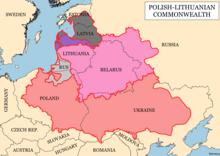
While the term "Poland" was also commonly used to denote this whole polity, Poland was in fact only part of a greater whole – the Polish–Lithuanian Commonwealth, which comprised primarily two parts:
- the Crown of the Polish Kingdom(Poland proper), colloquially "the Crown"
- the Grand Duchy of Lithuania, colloquially "Lithuania"
The Commonwealth was further divided into smaller administrative units known as
The lands that once belonged to the Commonwealth are now largely distributed among several Central and East European countries: Poland, Ukraine, Moldova (Transnistria), Belarus, Russia, Lithuania, Latvia, and Estonia.[269][270] Also some small towns in Upper Hungary (today mostly Slovakia), became a part of Poland in the Treaty of Lubowla (Spiš towns).
Other notable parts of the Commonwealth, without respect to region or voivodeship divisions, include:
- in the north-east;
- Warta Riversystem;
- Mazovia (Polish: Mazowsze), central Poland, with its capital at Warsaw;
- Lithuania Proper (Lithuanian: Didžioji Lietuva), northwest Grand Duchy, its most Catholic and ethnically Lithuanian part, capital Vilnius;
- Duchy of Samogitia (Lithuanian: Žemaitija; Polish: Żmudź), westernmost and most autonomous part of Grand Duchy of Lithuania, also the western part of Lithuania Proper, capital Raseiniai;
- Royal Prussia (Polish: Prusy Królewskie), at the southern shore of the Baltic Sea, was an autonomous area since the Second Peace of Thorn (1466), incorporated into the Crown in 1569 with the Commonwealth's formation;
- Ruthenia (Polish: Ruś), the eastern Commonwealth, adjoining Russia;
- Duchy of Livonia (Inflanty), a joint domain of the Crown and the Grand Duchy of Lithuania. Parts lost to Sweden in the 1620s and in 1660;
- Couronian colonization);
- Silesia (Polish: Śląsk) was not within the Commonwealth, but small parts belonged to various Commonwealth kings; in particular, the Vasa kings were dukes of Opole (Oppeln), Prudnik (Neustadt) and Racibórz (Ratibor) from 1645 to 1666.[271]

Commonwealth borders shifted with wars and treaties, sometimes several times in a decade, especially in the eastern and southern parts. After the Peace of Jam Zapolski (1582), the Commonwealth had approximately 815,000 km2 area and a population of 7.5 million.[237] After the Truce of Deulino (1618), the Commonwealth had an area of some 1 million km2 (990,000 km2) and a population of about 11 million.[238]
Geography
In the 16th century, the Polish bishop and
Kromer's works and other contemporary maps, such as those of Gerardus Mercator, show the Commonwealth as mostly plains. The Commonwealth's southeastern part, the Kresy, was famous for its steppes. The Carpathian Mountains formed part of the southern border, with the Tatra Mountain chain the highest, and the Baltic Sea formed the Commonwealth's northern border. As with most European countries at the time, the Commonwealth had extensive forest cover, especially in the east. Today, what remains of the Białowieża Forest constitutes the last largely intact primeval forest in Europe.[273]
Image gallery
- Politics and economy
-
Statuta Regni Poloniae in ordinem alphabeti digesta (Statutes of the Polish Kingdom, Arranged in Alphabetical Order), 1563
-
Grand Marshal of the Crown Łukasz Opaliński portraited with the insignium of his power in the parliament – the Marshal's cane, 1640
-
Orthodox Church of the Holy Spirit in Vilnius, designed by Johann Christoph Glaubitz, 1753–1756
-
Angelika Kauffmannin 1786.
-
Equestrian portrait of KingSigismund III of Poland, by Peter Paul Rubens, 1624
-
Tapestry with the arms of Michał Kazimierz Pac, Jan Leyniers, Brussels, 1667–1669
-
Silver tankard by Józef Ceypler, Kraków, 1739–1745
-
Example of the merchant architecture: Konopnica's tenement house in Lublin, 1575
-
Hussars' armours, first half of the 17th century
- Science, art and architecture
-
De republica emendanda (1554) by Andrzej Frycz Modrzewski, proposed a deep programme of reforms of the state, society and church.
-
Merkuriusz Polski Ordynaryjny, the first Polish newspaper published on the orders of Queen Marie Louise Gonzaga in 1661
-
Title page of Treny (1580) by Jan Kochanowski, a series of elegies upon the death of his beloved daughter, is an acknowledged masterpiece.
-
A plate from Michał Boym's Flora Sinensis (1656), the first description of an ecosystem of the Far East published in Europe[275]
-
Taurus Poniatovii, constellation originated by Marcin Poczobutt in 1777 to honor the king Stanisław II Augustus[276]
-
Branicki Palace in Białystok, designed by Tylman van Gameren, is sometimes referred to as the "Polish Versailles".
-
Pažaislis Monastery in Kaunas, Pietro Puttini, built 1674–1712
-
Church of St. Peter and St. Paul in Vilnius, Pietro Puttini, built 1675–1704
-
Zamość City Hall, designed by Bernardo Morando, is a unique example of Renaissance architecture in Europe, consistently built in accordance with the Italian theories of an "ideal town".[277]
See also
| History of the Polish–Lithuanian Commonwealth |
|---|
 |
|
|
- History of the Polish–Lithuanian Commonwealth (1569–1648)
- History of the Polish–Lithuanian Commonwealth (1648–1764)
- History of the Polish–Lithuanian Commonwealth (1764–1795)
- List of medieval great powers
- Armorial of Polish nobility
- List of szlachta
- Polish heraldry
- Lithuanian nobility
- Armenians in Poland
- History of the Germans in Poland
- History of the Jews in Poland
- History of Poland
- History of Lithuania
- Polish–Lithuanian–Ruthenian Commonwealth
- Polish–Lithuanian–Muscovite Commonwealth
Notes
- ^ Pro Fide, Lege et Rege was the motto since the 18th century.
a. ^ Name in native and official languages:
- Latin: Regnum Poloniae Magnusque Ducatus Lithuaniae / Serenissima Res Publica Poloniae[39]
- French: Royaume de Pologne et Grand-duché de Lituanie / Sérénissime République de Pologne et Grand-duché de Lituanie[279]
- Polish: Królestwo Polskie i Wielkie Księstwo Litewskie
- Lithuanian: Lenkijos Karalystė ir Lietuvos Didžioji Kunigaikštystė
- Belarusian: Каралеўства Польскае і Вялікае Княства Літоўскае (Karaleŭstva Polskaje і Vialikaje Kniastva Litoŭskaje)
- Ukrainian: Королівство Польське і Велике князівство Литовське
- German: Königreich Polen und Großfürstentum Litauen
b. ^ Some historians date the change of the Polish capital from Kraków to Warsaw between 1595 and 1611, although Warsaw was not officially designated capital until 1793.[280] The Commonwealth Sejm began meeting in Warsaw soon after the Union of Lublin and its rulers generally maintained their courts there, although coronations continued to take place in Kraków.[280] The modern concept of a single capital city was to some extent inapplicable in the feudal and decentralised Commonwealth.[280] Warsaw is described by some historians as the capital of the entire Commonwealth.[281][282] Wilno, the capital of the Grand Duchy,[283][284][285] is sometimes called the second capital of the entity.[286][287]
Notes
- ^ Royal banner used by the Vasa dynasty
- ^
- Polish: Rzeczpospolita Obojga Narodów;
- Latin: Res Publica Utriusque Nationis;
- Lithuanian: Abiejų Tautų Respublika, Žečpospolita;
- German: Republik beider Nationen, Republik beider Völker, Republik Polen-Litauen;
- Ukrainian: Річ Посполита;
- Belarusian: Рэч Паспалітая;
- Ruthenian: Рѣчъ Посполита
- ^
- Polish: Królestwo Polskie i Wielkie Księstwo Litewskie;
- Latin: Regnum Poloniae Magnusque Ducatus Lithuaniae;
- Lithuanian: Lenkijos Karalystė ir Lietuvos Didžioji Kunigaikštystė;
- German: Königreich Polen und des Großfürstentums Litauen
- Ukrainian: Королівство Польське і Велике князівство Литовське;
- Belarusian: Польскае Каралеўства і Вялікае Княства Літоўскае
- Robert Burton, in his The Anatomy of Melancholy, first published in 1621, writes of Poland: "Poland is a receptacle of all religions, where Samosetans, Socinians, Photinians ..., Arians, Anabaptists are to be found"; "In Europe, Poland and Amsterdam are the common sanctuaries [for Jews]".
References
- ^ a b Partitions of Poland at the Encyclopædia Britannica
- ^ a b Jagiellonian University Centre for European studies, "A Very Short History of Kraków", see: "1596 administrative capital, the tiny village of Warsaw". Archived from the original on 12 March 2009. Retrieved 29 November 2012.
- ^ ISBN 978-1-136-29636-9.
formed part of the Polish–Lithuanian Commonwealth which was ruled by Catholic monarchs who made Roman Catholicism the state religio...
- ^ a b Janusz Sykała: Od Polan mieszkających w lasach – historia Polski – aż do króla Stasia, Gdansk, 2010.
- ^ a b Georg Ziaja: Lexikon des polnischen Adels im Goldenen Zeitalter 1500–1600, p. 9.
- ^ "Artykuły henrykowskie – szlachecka prekonstytucja – Historia". polskieradio24.pl.
- ^ "Poland – The First Partition | Britannica". www.britannica.com.
- ^ ISBN 83-7000-016-9.
- ^ Bertram Benedict (1919): A history of the great war. Bureau of national literature, inc. p. 21.
- ^ According to Panstwowe Przedsiebiorstwo Wydawnictw Kartograficznych: Atlas Historyczny Polski, wydanie X, 1990, p. 16, ~ 990.000 km2
- ISBN 978-1-4766-8187-0.
- ^ Zbigniew Pucek: Państwo i społeczeństwo 2012/1, Krakow, 2012, p. 17.
- ^ Norman Davies, Europe: A History, Pimlico 1997, p. 554: "Poland–Lithuania was another country which experienced its 'Golden Age' during the sixteenth and early seventeenth centuries. The realm of the last Jagiellons was absolutely the largest state in Europe"
- ISBN 978-0-415-25491-5. Retrieved 13 August 2011.
- ^ Bertram Benedict (1919). A history of the great war. Bureau of national literature, inc. p. 21. Retrieved 13 August 2011.
- ^ According to Panstwowe Przedsiebiorstwo Wydawnictw Kartograficznych: Atlas Historyczny Polski, wydanie X, 1990, p. 16, 990.000 km2
- ^ ISBN 0880293942
- ^ According to Panstwowe Przedsiebiorstwo Wydawnictw Kartograficznych: Atlas Historyczny Polski, wydanie X, 1990, p. 16, just over 9 million in 1618.
- ^
- ^ Gudavičius, Edvardas. "Lietuvos feodalinės visuomenės ir jos valdymo sistemos genezė: 2 dalis" (PDF). Ministry of the Interior (Lithuania) (in Lithuanian). p. 8. Retrieved 18 November 2023.
- ^ Spečiūnas, Vytautas. "Jonas Albrechtas". Visuotinė lietuvių enciklopedija (in Lithuanian). Retrieved 18 November 2023.
- ^ ISBN 0-19-925340-4
- academic journal mission statement: "Polish–Lithuanian Commonwealth was ... characterized by religious tolerance unusual in premodern Europe"
- ISBN 0-313-30932-9.
- ^ ISBN 0415285801.
- ISBN 0253346274.
- ISBN 9781107043091.
- ^ "In the mid-1500s, united Poland was the largest state in Europe and perhaps the continent's most powerful state politically and militarily". "Poland". Encyclopædia Britannica. 2009. Encyclopædia Britannica Online. Retrieved 26 June 2009.
- ISBN 0-8135-0799-5.
- ISBN 0-521-80756-5p. 54.
- ^ Economic History Review30:1 (March), pp. 18–32.
- ISBN 978-0-8377-0362-6.
- ISBN 0-14-044495-5.
May second oldest constitution.
- ISBN 0-8039-9019-7, p. 121.
- ^ ISBN 0-19-820171-0.
- ^ a b c "Regnum Poloniae Magnusque Ducatus Lithuaniae – definicja, synonimy, przykłady użycia". sjp.pwn.pl. Retrieved 27 October 2016.
- ^ a b Ex quo serenissima respublica Poloniae in corpore ad exempluin omnium aliarnm potentiarum, lilulum regiuin Borussiae recognoscere decrevit (...)
Antoine-François-Claude Ferrand (1820). "Volume 1". Histoire des trois démembremens de la Pologne: pour faire suite à l'histoire de l'Anarchie de Pologne par Rulhière (in French). Deterville. p. 182. - ^ the name given by Marcin Kromer in his work Polonia sive de situ, populis, moribus, magistratibus et re publica regni Polonici libri duo, 1577.
- ^ the therm used for instance in Zbior Deklaracyi, Not I Czynnosci Głownieyszych, Ktore Poprzedziły I Zaszły Pod Czas Seymu Pod Węzłem Konfederacyi Odprawuiącego Się Od Dnia 18. Wrzesnia 1772. Do 14 Maia 1773
- ^ Name used for the common state, Henryk Rutkowski, Terytorium, w: Encyklopedia historii gospodarczej Polski do 1945 roku, t. II, Warszawa 1981, s. 398.
- ^ Richard Buterwick. The Polish Revolution and the Catholic Church, 1788–1792: A Political History. Oxford University Press. 2012. pp. 5, xvii.
- ^ 1791 document signed by the King Stanislaw August "Zareczenie wzaiemne Oboyga Narodow" pp. 1, 5 [1]
- ISBN 978-83-8123-881-6.
- ^ Jasienica 1997, pp. 30–32
- ^ a b c Halecki 1991, p. 52
- ^ Halecki 1991, p. 71
- ISBN 1-86064-061-3.
- ISBN 0-88033-206-9.
- ^ Jasienica 1997, p. 63
- ^ Halecki 1991, p. 155
- ISBN 83-7195-853-6.
- ISBN 978-963-9116-42-9
- ^ Butterwick 2021, pp. 12–14
- ^ Butterwick 2021
- ISBN 978-0-300-25220-0.
- ISBN 978-83-89624-59-8.
- ISBN 83-01-03732-6.
- ^ a b Butterwick 2021, p. 21
- ISBN 978-83-7188-973-8.
- ^ Pernal 2010, p. 10
- ^ a b Maniecky & Szajnocha 1869, p. 504
- ^ Maniecky, Wojciech; Szajnocha, Karol (1869). Dziennik Literacki (in Polish). Ossoliński. p. 504.
- ^ The death of Sigismund II Augustus in 1572 was followed by a three-year Interregnum during which adjustments were made in the constitutional system. The lower nobility was now included in the selection process, and the power of the monarch was further circumscribed in favor of the expanded noble class. From that point, the king was effectively a partner with the noble class and constantly supervised by a group of senators.
"The Elective Monarchy". Poland – The Historical Setting. Federal Research Division of the Library of Congress. 1992. Archived from the original on June 4, 2011. Retrieved July 15, 2011. - ^ Bardach, Juliusz (1987). Historia państwa i prawa polskiego (in Polish). Warszawa: PWN. pp. 216–217.
- ^ a b c d Bardach 1987, pp. 216–217
- ISBN 0-295-98093-1.
- ^ Besala, Jerzy; Biedrzycka, Agnieszka (2005). Stefan Batory: Polski Słownik Biograficzny (in Polish). Vol. XLIII. p. 116.
- ^ a b Besala & Biedrzycka 2005, p. 116
- ^ Besala & Biedrzycka 2005, p. 117
- ^ Besala & Biedrzycka 2005, pp. 116–117
- ^ a b Besala & Biedrzycka 2005, pp. 118–119
- ^ Besala & Biedrzycka 2005, pp. 121
- ^ Szujski, Józef (1894). Dzieła Józefa Szujskiego. Dzieje Polski (in Polish). Vol. 3. Kraków: Szujski-Kluczycki. p. 139. Retrieved 9 January 2021.
- ^ pisze, Przemek (3 July 2013). "Bitwa pod Byczyną. Zamoyski upokarza Habsburgów i gwarantuje tron Zygmuntowi III – HISTORIA.org.pl – historia, kultura, muzea, matura, rekonstrukcje i recenzje historyczne". Retrieved 16 November 2016.
- ^ Kizwalter, Tomasz (1987). Kryzys Oświecenia a początki konserwatyzmu polskiego (in Polish). Warszawa (Warsaw): Uniwersytet Warszawski. p. 21. Retrieved 3 May 2021.
- ^ Szujski 1894, p. 161
- ISBN 978-1-4766-0411-4. Retrieved 14 January 2021.
- ^ Peterson 2014, p. 107
- ISBN 978-0-8191-2509-5. Retrieved 1 February 2021.
- ISBN 978-1-5017-5740-2. Retrieved 18 February 2021.
- ISBN 978-0-87586-687-1. Retrieved 1 February 2021.
- ISBN 978-0-521-29713-4. Retrieved 11 April 2019.
- ISBN 978-1-5099-1766-2. Retrieved 18 February 2021.
- ^ Dyer, Thomas Henry (1861). The History of Modern Europe. Vol. From the Fall of Constantinople, in 1453, to the War in the Crimea, in 1857. Volume 2. London: J. Murray. p. 504. Retrieved 20 February 2021.
- ISBN 83-05-11452-X.
- ^ Gillespie 2017, p. 141
- ISBN 978-83-01-01363-9. Retrieved 8 January 2021.
- ^ Czapliński, Władysław (1976). Władysław IV i jego czasy [Władysław IV and His Times] (in Polish). Warsaw: PW "Wiedza Poweszechna". pp. 102–118.
- ^ Czapliński 1976, p. 170
- ^ Czapliński 1976, p. 202
- ^ Czapliński 1976, pp. 353–356
- ^
- ^ Poland, the knight among nations, Louis Edwin Van Norman, New York: 1907, p. 18.
- ISBN 0-495-09766-7.
- ^ Gintel, Jan (1971). Wiek XVIII–XIX. Polska: Wydawnictwo Literackie. p. 143.
- ^ Gintel 1971, p. 143
- ^ Instytut Badań Literackich (1969). Studia staropolskie. Vol. 24, 25. Polska: Zakład Ossolińskich. p. 172.
- ^ Instytut Badań Literackich 1969, p. 172
- ^ Borucki, Marek (1976). Jak w dawnej Polsce królów obierano. Polska: Ludowa Spółdzielnia Wydawnicza. pp. 138–143.
- ISBN 978-83-7220-560-5.
- ^ Borucki 1976, pp. 138–143
- ^ Dobrowolski (1962). Historia sztuki polskiej w zarysie: Sztuka nowożytna. Polska: Wydawnictwo Literackie.
- ISBN 978-83-7006-384-9.
- ISBN 978-83-214-0861-3.
- ISBN 978-0-582-06429-4.
- ISBN 978-1-85109-667-1.
- ^ Tucker 2010, p. 710
- ^ Chisholm, Hugh, ed. (1911). . Encyclopædia Britannica. Vol. 21 (11th ed.). Cambridge University Press. pp. 981–982.
- ^ Lindsey, J. O. (ed). The Cambridge New Modern History, Volume 7.
- ^ a b Brückner 1931, p. 157
- ISBN 978-0-8014-3714-4.
polish lithuanian commonwealth americas western europe.
- ^ Spórna 2003
- ISBN 978-83-11-11606-1. Retrieved 26 September 2014.
- ISBN 978-83-01-14187-5.
- ISBN 978-0-231-12819-3.
- ISBN 978-0-415-35491-2.
- ISBN 978-963-386-276-6.
- ^ Sužiedėlis 2011, p. xxv.
- ^ Andrzej Jezierski, Cecylia Leszczyńska, Historia gospodarcza Polski, 2003, s. 68.
- ^ Russia's Rise as a European Power, 1650–1750 Archived 5 April 2020 at the Wayback Machine, Jeremy Black, History Today, Vol. 36 Issue: 8, August 1986.
- ISBN 978-83-88865-08-4. Retrieved 13 February 2021.
- ISBN 978-1-113-14791-2.
- ^ ISBN 0-313-31878-6. Retrieved 3 September 2006.
- ^ Josef Macha (1974). Ecclesiastical Unification. Pont. Institutum Orientalium Studiorum. p. 154.
- ISBN 978-91-89-31563-1.
- ^ Joanna Olkiewicz, Najaśniejsza Republika Wenecka (Most Serene Republic of Venice), Książka i Wiedza, 1972, Warszawa
- ]
- ^ Frost, Robert I. The Northern Wars: War, State and Society in northeastern Europe, 1558–1721. Harlow, England; New York: Longman's. 2000. Especially pp. 9–11, 114, 181, 323.
- ^ ISBN 978-0-231-14054-6.
- ^ ISBN 0-7190-2381-5.
- ISBN 978-0-521-54402-3.
- ^ ]
- ^ ]
- ]
- ^ Carl L. Bucki, The Constitution of May 3, 1791 Archived 5 December 2008 at the Wayback Machine, Text of a presentation made at the Polish Arts Club of Buffalo on the occasion of the celebrations of Poland's Constitution Day on 3 May 1996. Retrieved 20 March 2006.
- ^ ].
- ^ Niepodległość. Vol. 6. Polska: Fundacja "Polonia Restituta,". 1991. Retrieved 13 February 2021.
- ^ a b c Sobiech, Marcin (2018). "Jak powstawała i co zawiera mapa Rzeczpospolitej Obojga Narodów". Exgeo (in Polish). Marcin Sobiech. Retrieved 16 February 2021.
- ^ Kucharczuk 2011, p. 64
- ^ "shillings – Polish translation – Linguee". Linguee.com. Retrieved 27 April 2018.
- ISBN 978-83-10-08779-9.
- ^ "Pierwsze polskie banknoty". Skarbnica Narodowa (in Polish). Retrieved 16 February 2021.
- ^ Gdańskie Towarzystwo Naukowe (1991). Seria popularno-naukowa "Pomorze Gdańskie" (in Polish). Vol. 19. Gdańsk: Towarzystwo Naukowe. p. 149. Retrieved 16 February 2021.
- ISBN 978-83-7705-120-7. Retrieved 16 February 2021.
- ^ a b Zsigmond Pál Pach, Zs. P. Pach (1970). The role of East-Central Europe in international trade, 16th and 17th centuries. Akadémiai Kiadó. p. 220.
- ^ ISBN 0-88033-186-0.
- ^ Krzysztof Olszewski (2007). The Rise and Decline of the Polish–Lithuanian Commonwealth due to Grain Trade. pp. 6–7.
- ^ Maciej Kobyliński. "Rzeczpospolita spichlerzem Europy". www.polinow.pl (in Polish). Retrieved 28 December 2009.
- ISBN 0-8022-2407-5.
- ISBN 91-971048-8-4.
- ISBN 978-83-280-2203-4. Retrieved 16 February 2021.
- ^ "Welcome to Encyclopædia Britannica's Guide to History". Britannica.com. 31 January 1910. Retrieved 1 February 2009.
- ISBN 0-86091-710-X.
- ^ ISBN 978-0-415-36627-4.
- ^ Manchester UniversityPress. p. 151.
- ^ Krzysztof Olszewski (2007). The Rise and Decline of the Polish–Lithuanian Commonwealth due to Grain Trade (PDF). p. 7. Retrieved 22 April 2009.[permanent dead link]
- ISBN 90-04-13896-X.
- ^ Allen, Robert. "Economic Structure and agricultural productivity in Europe, 1300–1800" (PDF). Retrieved 5 May 2015.
- ^ kurkowski, Jan (2010). "Jarmarki w województwie lubelskim w XVI w." Pasaż Wiedzy. Muzeum Pałacu Króla Jana III w Wilanowie. Retrieved 16 February 2021.
- ^ Billock, Jennifer (2019). "Follow the Ancient Amber Road". Smithsonian Magazine. Smithsonian. Retrieved 16 February 2021.
- ^ "Drogi handlowe w dawnej Polsce". PWN. Encyklopedia PWN. Retrieved 16 February 2021.
- ^ Polskie Towarzystwo Historyczne (1989). Kwartalnik historyczny. Vol. 3–4. Polskie Towarzystwo Historyczne. p. 214. Retrieved 16 February 2021.
- ^ ""Polonaise" carpet". museu.gulbenkian.pt. Archived from the original on February 28, 2003. Retrieved May 18, 2009.
- ^ a b Stachowicz 1894, p. 279
- ^ Tomaszewska, A. "Wolna elekcja i zasady jej funkcjonowania" (PDF). Tomaszewska. Retrieved 16 February 2021.
- ^ Juliusz Bardach; Zdzisław Kaczmarczyk; Bogusław Leśnodorski (1957). Historia państwa i prawa Polski do roku 1795 (in Polish). Vol. 2. Polska: Państwowe Wydawn. Naukowe. pp. 306–308. Retrieved 16 February 2021.
- ]
- ^ Stachowicz, Michał (1894). Wojsko polskie Kościuszki w roku 1794 (in Polish). Poznań: Księgarnia Katolicka. pp. 23–25. Retrieved 14 February 2021.
- ^ Stachowicz 1894, pp. 23–25
- ^ Juliusz Bardach, Boguslaw Lesnodorski, and Michal Pietrzak, Historia panstwa i prawa polskiego (Warsaw: Paristwowe Wydawnictwo Naukowe), 1987, p. 229.
- ^ Brzezinski (1988), p. 6.
- ^ a b c d e f g Bardach et al. (1987), pp. 229–230.
- ^ a b Brzezinski (1987), p. 10.
- ^ Bardach et al. (1987), pp. 227–228.
- ISBN 978-83-86268-27-6. Retrieved 13 February 2021.
- ^ ISBN 0-521-24093-X.
- ISBN 0-19-859381-3.
- ISBN 0-231-12819-3.
- ^ "Setting Sail". www.warsawvoice.pl. 29 May 2003. Archived from the original on 26 January 2008. Retrieved 21 May 2009.
- ^ Paul Peucker. "Jan Amos Comenius (1592–1670)" (PDF). www.moravian.org. Archived from the original (PDF) on September 2, 2009. Retrieved May 18, 2009.
- ISBN 978-08-19-12509-5.
- ^ "Portraits collection". muzeum.leszno.pl. Retrieved 18 May 2009.
- ISBN 83-213-3412-1.
- ^ .
- ^ Szablowski, Jerzy (1975). Arrasy flamandzkie w zamku królewskim na Wawelu (in Polish). Polska: Arkady. p. 15. Retrieved 13 February 2021.
- ^ Szablowski, Jerzy (1975). Arrasy flamandzkie w zamku królewskim na Wawelu (in Polish). Polska: Arkady. Retrieved 13 February 2021.
- ISBN 978-83-87730-72-7. Retrieved 13 February 2021.
- ^ Singleton, Esther (12 December 2019). "French and English furniture distinctive styles and periods described and illustrated". Good Press – via Google Books.
- ^ Dialog. Miesiȩcznik poświȩcony dramaturgii współczesnej, teatralnej, filmowej, radiowej, telewizyjnej. Vol. 11. Polska: RSW "Prasa". 1966. p. 6. Retrieved 13 February 2021.
- ISBN 0-87830-026-0.
- ^ Lubliner, Ludwig (1858). Obrona Żydów zamieszkałych w krajach polskich od niesłusznych zarzutów i fałszywych oskarzeń. Brussels: C. Vanderauwer. p. 7. Retrieved 13 February 2021.
- ISBN 978-3-7845-7612-1. Retrieved 13 February 2021.
- ^ Państwowy Instytut Badania Sztuki Ludowej (1974). "Volumes 28–29". Polska sztuka ludowa (Polish Folk Art). Państwowy Instytut Sztuki. p. 259.
- ISBN 0-8020-7820-6.
- ^ a b Michael J. Mikoś. "Baroque". www.staropolska.pl. Retrieved 13 May 2009.
- ISBN 978-83-7363-029-1. Retrieved 13 February 2021.
- ^ Kowalczyk, Jerzy (1973). Sebastiano Serlio a sztuka polska. Polska: Zakład Narodowy im. Ossolińskich. p. 119. Retrieved 13 February 2021.
- ISBN 978-83-85739-14-2.
- ISBN 978-83-901494-2-4. Retrieved 13 February 2021.
- ISBN 978-83-900152-8-6. Retrieved 13 February 2021.
- ISBN 978-83-7306-068-5. Retrieved 13 February 2021.
- ^ "Palaces and Castles in a Lion Country". www.lvivtoday.com.ua. 2 June 2008. Archived from the original on 25 April 2020. Retrieved 19 May 2009.
- ISBN 978-83-01-12917-0. Retrieved 13 February 2021.
- ISBN 83-231-0239-2. W każdym razie "królowa bez korony i pierwsza dama Rzeczypospolitej", jak współcześni określali Sieniawską, zasługuje na biografię naukową.
- ^ Andrzej Wasko, Sarmatism or the Enlightenment: <space>The Dilemma of Polish Culture, Sarmatian Review XVII:2, online
- ^ Dziejochciejstwo, dziejokrętactwo, Janusz Tazbir, Polityka 6 (2591) 10 February 2007 (in Polish)
- ISBN 978-83-87704-94-0.
- ISBN 978-83-11-11724-2.
- ^ a b Kopczyński & Tygielski 2010
- ^ Kopczyński & Tygielski 2010, p. 236
- ^ a b Kopczyński & Tygielski 2010, p. 237
- ^ R. B. Wernham, The new Cambridge modern history: The Counter-Reformation and price revolution, 1559–1610, 1968, Cambridge University Press, Google print p. 377
- ^ a b Matthew P. Romaniello, Charles Lipp. Contested Spaces of Nobility in Early Modern Europe. Ashgate Publishing, Ltd. 2011. p. 233.
- ^ Polish Sociological Review (in Polish). Polish Sociological Association. 2007. p. 96.
- ^ Kopczyński & Tygielski 2010, p. 201
- ^ Kopczyński & Tygielski 2010, pp. 25–83
- ^ a b Kopczyński & Tygielski 2010, pp. 29–38
- ^ Stone, Daniel, The Polish-Lithuanian State, 1386–1795, Seattle and London: University of Washington Press, 2001.
- ISBN 0199253390, 0199253404
- ISBN 978-1-4426-1021-7.
- ISBN 978-0-7546-6825-1.
- ^ Piekarski, Adam (1979). Freedom of Conscience and Religion in Poland. Interpress Publishers. p. 31.
- ^ a b "Memory of the World Register Nomination Form". portal.unesco.org. Retrieved 2 August 2011.
- ISBN 0-521-86403-8.
- ^ "Lemberg". Catholic Encyclopedia. Retrieved 3 September 2010.
- ISBN 978-0-7316-7503-6.
- ISBN 978-1-4426-1021-7.
- ^ "Poland, history of", Encyclopædia Britannica from Encyclopædia Britannica Premium Service. [2]. Retrieved 10 February 2006 Archived 1 November 2004 at the Wayback Machine and "Ukraine", Encyclopædia Britannica from Encyclopædia Britannica Premium Service. [3]. Retrieved 14 February 2006. Archived 24 January 2005 at the Wayback Machine
- ^ "European Jewish Congress – Poland". Eurojewcong.org. Archived from the original on 11 December 2008. Retrieved 1 February 2009.
- ISBN 0-415-29667-6.
- ^ ISBN 9955-475-94-3.
- ^ a b Aleksander Gieysztor, ed. (1988). Rzeczpospolita w dobie Jana III (Commonwealth during the reign of John III). Royal Castle in Warsaw. p. 45.
- ^
- ^
- ^
- ^ a b Daniel. Z Stone, A History of East Central Europe, p. 46.
- ISBN 978-0-230-55070-4.
- ^ L'union personnelle polono-saxonne contribua davantage à faire connaître en Pologne le français que l'allemand. Cette fonction de la langue française, devenue l'instrument de communication entre les groupes dirigeants des deux pays. Polish Academy of Sciences Institute of History (1970). "Volume 22". Acta Poloniae historica (in French). National Ossoliński Institute. p. 79.
- ISBN 0-19-820701-8.
- ^ України, ЦДЕА. "Державна архівна служба України". archives.gov.ua.
- ^ Although still sometimes in use by the end of the XVII century and lack of official decree like one for Grand Duchy chancellery, there was no separate Ruthenian Metrica since 1673.
- Žygimantas Augustas' in 1552...//Courts juratory were written in Lithuanian language. In fact, such [courts juratory written in Lithuanian] survived from the 17th century...
- ^ ""Mes Wladislaus..." a letter from Wladyslaw Vasa issued in 1639 written in Lithuanian language". Retrieved 3 September 2006.
- ISBN 9955-445-26-2.)
In 1794 Government's declarations were carried out and in Lithuanian.
{{cite book}}: CS1 maint: location missing publisher (link - ^ Daniel. Z Stone, A History of East Central Europe, p. 4.
- ^ ISBN 0-8032-3240-3.
- ISBN 83-7063-286-6. Podobną opinię przekazał nieco późnej, w 1577 r. Marcin Kromer "Za naszej pamięci weszli [...] do głównych miast Polski kupcy i rzemieślnicy włoscy, a język ich jest także częściowo w użyciu, mianowicie wśród wytworniejszych Polaków, którzy chętnie podróżują do Włoch".
- ISBN 0-8063-1378-1.
- ISBN 0-88397-131-3. In 1600 the son of the chancellor of Poland was learning four languages: Latin, Greek, Turkish, and Polish. By the time he had completed his studies, he was fluent not only in Turkish but also in Tatar and Arabic.
- ISBN 0-7591-0973-7.
- ISBN 978-1-000-73113-2.
- Constitution of the Republic of Polandof 1997.
- ISBN 0312224583. Print, p. 78
- ^ Grzegorz Górny (23 August 2008). "Zobaczyć Kresy" (in Polish). Rzeczpospolita. Archived from the original on 10 July 2015. Retrieved 1 February 2009.
- ISBN 978-1-74104-481-2.
- ISBN 0-89774-940-5.
- ISBN 1-57607-243-6.
- ISBN 978-88-70-88537-8.
- ISBN 0-521-00109-9.
- ISBN 0-19-518948-5.
- ISBN 0-7007-1458-8.
- ^ Ian Ridpath. "Taurus Poniatovii – Poniatowski's bull". www.ianridpath.com. Retrieved 18 May 2009.
- ^ "Old City of Zamość". UNESCO World Heritage Centre. 23 September 2009. Retrieved 15 September 2011.
- ^ After a fire had destroyed a wooden synagogue in 1733 Stanislaw Lubomirski decided to found a new bricked synagogue building. Polin Travel. "Lancut". www.jewish-guide.pl. Retrieved 2 September 2010.
- ^ Guillaume de Lamberty (1735). "Volume 3". Mémoires pour servir à l'histoire du XVIIIe siècle, contenant les négociations, traitez, résolutions et autres documents authentiques concernant les affaires d'état: avec le supplément aux années MDCXCVI–MDCCIII (in French). p. 343.
Généreux et Magnifiques Seigneurs les Sénateurs et autres Ordres de la Sérénissime République de Pologne et du grand Duché de Lithuanie
- ^ ISBN 978-0-521-41239-1.
- ISBN 978-0-295-98093-5.
- ISBN 978-0-415-16111-4.
- ISBN 978-0-06-097468-8.
vilnius capital grand duchy.
- ^ Politics and reformations: communities, polities, nations, and empires. 2007 p. 206.
- ^ Zeitschrift für Ostmitteleuropa-Forschung. 2006, Vol. 55; p. 2.
- ISBN 978-90-04-16173-3.)
{{cite book}}: CS1 maint: multiple names: authors list (link - ISBN 978-90-272-3453-7.)
{{cite book}}: CS1 maint: multiple names: authors list (link
Bibliography
- Bardach, Juliusz; Lesnodorski, Boguslaw; Pietrzak, Michal (1987). Historia panstwa i prawa polskiego. Warsaw: Paristwowe Wydawnictwo Naukowe. ISBN 978-83-01-07919-2.
- Brzezinski, Richard (1987). Polish Armies (1): 1569–1696. Men-At-Arms Series. Vol. 184. Osprey Publishing. ISBN 0-85045-736-X.
- Brzezinski, Richard (1988). Polish Armies (2): 1569–1696. Men-At-Arms Series. Vol. 188. Osprey Publishing. ISBN 0-85045-744-0.
- Frost, Robert (2015). The Oxford History of Poland–Lithuania. Vol. I: The Making of the Polish–Lithuanian Union, 1385–1569. Oxford University Press. ISBN 978-0-19-820869-3.
- Litwin, Henryk (October 2016). "Central European Superpower". BUM Magazine.
- Norkus, Zenonas (2017). An Unproclaimed Empire: The Grand Duchy of Lithuania: From the Viewpoint of Comparative Historical Sociology of Empires. ISBN 978-1-138-28154-7.
- Rowell, S. C. (2014). Lithuania Ascending: A Pagan Empire within East-Central Europe, 1295–1345. Cambridge Studies in Medieval Life and Thought: Fourth Series. Cambridge University Press. ISBN 978-1-107-65876-9.
- Rowell, S. C.; Baronas, Darius (2015). The Conversion of Lithuania. From Pagan Barbarians to Late Medieval Christians. Vilnius: Institute of Lithuanian Literature and Folklore. ISBN 978-609-425-152-8.
- Stone, Daniel Z. (2014). The Polish–Lithuanian State, 1386–1795. ISBN 978-0-295-80362-3.
- Sužiedėlis, Saulius A. (2011). Historical Dictionary of Lithuania (2 ed.). Scarecrow Press. ISBN 978-0-8108-7536-4.
External links
 Media related to Polish-Lithuanian Commonwealth at Wikimedia Commons
Media related to Polish-Lithuanian Commonwealth at Wikimedia Commons- Commonwealth of Diverse Cultures: Poland's Heritage Archived 24 June 2011 at the Wayback Machine (in Polish and English)
- Knowledge passage (in Polish)
- The Polish–Lithuanian Commonwealth–Maps, history of cities in Poland, Ukraine, Belarus and Lithuania Archived 17 April 2021 at the Wayback Machine (in Polish)
- The Polish-Lithuanian Commonwealth on BBC Radio 4 "In Our Time" 14 Oct. 2021, Melvyn Bragg with Robert I. Frost, University of Aberdeen, Katarzyna Kosior, Northumbria University and Norman Davies, University of Oxford





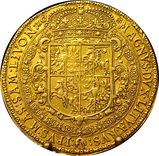





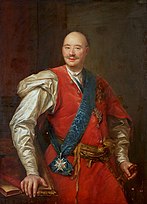



![18th century amber casket. Gdańsk patronised by the Polish court flourished as the center for amber working in the 17th century.[274]](http://upload.wikimedia.org/wikipedia/commons/thumb/0/09/Malbork_%28DerHexer%29_2010-07-14_067.jpg/150px-Malbork_%28DerHexer%29_2010-07-14_067.jpg)

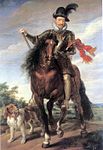


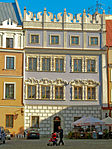




![A plate from Michał Boym's Flora Sinensis (1656), the first description of an ecosystem of the Far East published in Europe[275]](http://upload.wikimedia.org/wikipedia/commons/thumb/8/8b/Flora_Sinensis_-_Mango.JPG/107px-Flora_Sinensis_-_Mango.JPG)
![Taurus Poniatovii, constellation originated by Marcin Poczobutt in 1777 to honor the king Stanisław II Augustus[276]](http://upload.wikimedia.org/wikipedia/commons/thumb/7/7a/Taurus_Poniatovii.PNG/150px-Taurus_Poniatovii.PNG)


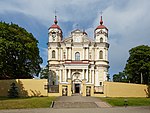
![Zamość City Hall, designed by Bernardo Morando, is a unique example of Renaissance architecture in Europe, consistently built in accordance with the Italian theories of an "ideal town".[277]](http://upload.wikimedia.org/wikipedia/commons/thumb/a/a4/Ratusz_Zamosc.jpg/150px-Ratusz_Zamosc.jpg)

![Łańcut Synagogue was established by Stanisław Lubomirski, 1733.[278]](http://upload.wikimedia.org/wikipedia/commons/thumb/9/9a/%C5%81a%C5%84cut_synagoga_06.jpg/100px-%C5%81a%C5%84cut_synagoga_06.jpg)

